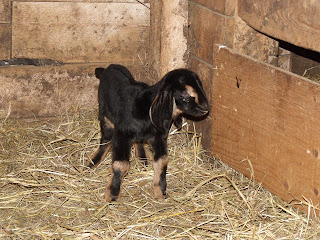On a "positive" note. There were other creature that were reasonably prices. I can tell you now there is a good chance I will be winning father of the year after bringing home these two "pets". The girls were and still are very excited about the new additions. The Appaloosa is a 16 month old gelding and the bay coloured is an 8 month old filly. Very affectionate little fellows. The girls will be responsible for basic obedience training over the next year. The horses cannot be ridden until they are 2.5-3 years old. But training starts now.
 We are not really horse people. Horse people can be pretty extreme. However we do enjoy horses. Unlike other livestock they can have a genuine affection for their caretakers. Sheep, cattle, pigs, chicken, etc. only really care that you bring food. The gelding was afraid of the trailer while. So after several attempts and praise and petting, I could tell he was not sure about the trailer. While stroking his neck and telling him it would be OK, he leaned into me placing his head against my chest. If horses could hug that was one. He eventually loaded and was fine on the trip home.
We are not really horse people. Horse people can be pretty extreme. However we do enjoy horses. Unlike other livestock they can have a genuine affection for their caretakers. Sheep, cattle, pigs, chicken, etc. only really care that you bring food. The gelding was afraid of the trailer while. So after several attempts and praise and petting, I could tell he was not sure about the trailer. While stroking his neck and telling him it would be OK, he leaned into me placing his head against my chest. If horses could hug that was one. He eventually loaded and was fine on the trip home.  Lynn's Polish hen decided it was time to be a mother hen. A Polish hen is a funny looking thing. They are the only white egg layers we have. It takes 21 days of dedication from the hen to sit on eggs in order to hatch them out. Several chickens share a nest box, so we don't know who actually laid the eggs that this girl hatched. We collect our eggs on a daily basis, but ever once and a while the hens find a new hiding spot. These guys were hatched out in the wall of the barn.
Lynn's Polish hen decided it was time to be a mother hen. A Polish hen is a funny looking thing. They are the only white egg layers we have. It takes 21 days of dedication from the hen to sit on eggs in order to hatch them out. Several chickens share a nest box, so we don't know who actually laid the eggs that this girl hatched. We collect our eggs on a daily basis, but ever once and a while the hens find a new hiding spot. These guys were hatched out in the wall of the barn. We keep a few goats, I am not sure why because they can be a real handful. This little girl was born this week and looks to be in good health. when we have more time, such as through the winter we like to milk the goats. They provide excellent milk that is far more nutritious than the watered down, broken down stuff you buy in the store. Goat milk is much easier to digest then cow milk because of the different sugars (lactose) and the fat globules are smaller making them easier to digest. Goats are one of the other animals on the farm that has a personality. But that is not always a good thing.
We keep a few goats, I am not sure why because they can be a real handful. This little girl was born this week and looks to be in good health. when we have more time, such as through the winter we like to milk the goats. They provide excellent milk that is far more nutritious than the watered down, broken down stuff you buy in the store. Goat milk is much easier to digest then cow milk because of the different sugars (lactose) and the fat globules are smaller making them easier to digest. Goats are one of the other animals on the farm that has a personality. But that is not always a good thing. 








